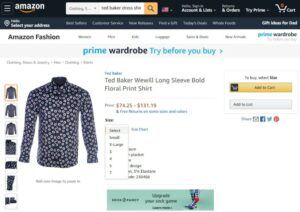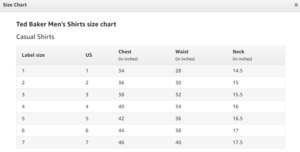Amazon Marketplace plans to introduce new apparel size standards, which resolve a key listing pain point for customers before the end of 2020. Currently, when it comes time to select a size for an apparel purchase, customers see a slew of options in multiple formats that don’t appear to relate to each other at all.


Small, X-large, 3, 4, 5, 7: some of these sizes are not like the others
While Amazon does display clear and descriptive size charts for most major apparel brands, if one Amazon Marketplace third-party seller uploads a variation with a size value that doesn’t exist on the brand’s size chart, customers are left to figure out how those sizes relate to each other (shown, in the example, above).


No “Small,” no “X-Large,” can mean that a customer is forced to make their best guess when selecting a size
Because Amazon has historically allowed sellers to list apparel products using any size system they please, the marketplace is replete with listings that aggregate offers from multiple sellers using different size systems. This creates major issues for any customer who simply wants to buy the right size on their first attempt and avoid a time-wasting cycle of purchases and returns until finally landing upon the size that fits best.
This experience also presents a threat to a brand’s reputation when their products are sold on Amazon by distributors and resellers. Ted Baker eschews small/medium/large sizing for their unique numerical system, but the company cannot stop a reseller from using “large” instead of “4” in the size field. As a result, finding the right size of a Ted Baker shirt is more difficult on Amazon than it is on tedbaker.com, which does not create a great customer experience.
As part of Amazon’s size changes, apparel sellers on the marketplace will be required to provide:
- Specify the sizing system. Specify the sizing system used by a product (examples: numeric, alpha, age range)
- Specific size types. Use standardized size and size range values that correspond to the sizing system used (e.g., Small-Medium, 8 Years)
- Special sizing. Append predetermined suffixes to denote whether a product is plus-sized, tall, petite, etc.
Sellers can also use apparel-specific size types, so a men’s dress shirt can be listed using its neck size and sleeve length, or a bra can be listed using its cup size and band size.
Additionally, Amazon is warning sellers that listings with sizes that appear inaccurate or incorrectly formatted may get hidden on product pages. Amazon has instructed sellers to conform to the size standards listed on the Apparel Size Standards page in Seller Central to avoid having any sizes hidden from view. Similar changes were made to the footwear category in 2019 and greatly reduced instances of US and UK sizes being co-mingled, providing a clear, easy buying experience. This is the goal with apparel sizing as well to make the experience for the customer better and reduce the number of purchase and return cycles.
Learn more about Amazon’s apparel size standards updates on Seller Central (Seller Central login required). Or, reach out to your Rithum client executive to find out how we can help you meet these new standards.